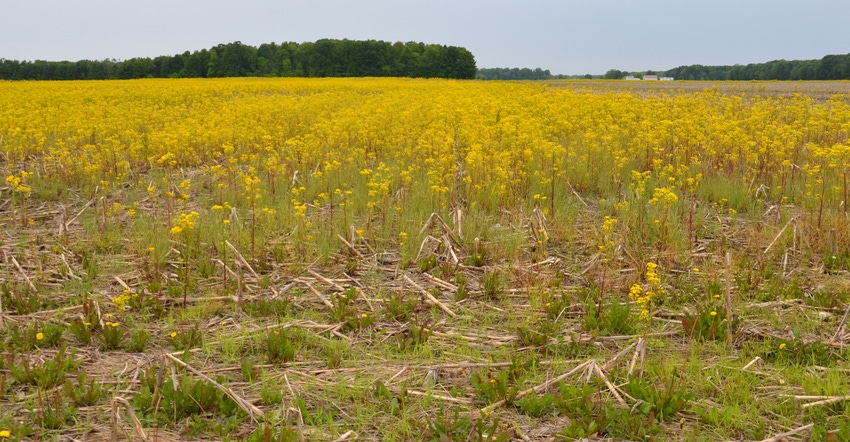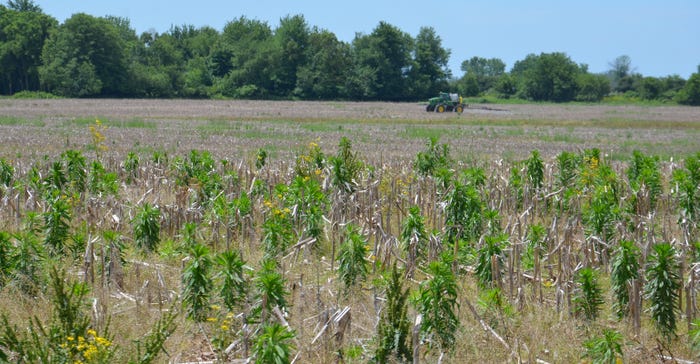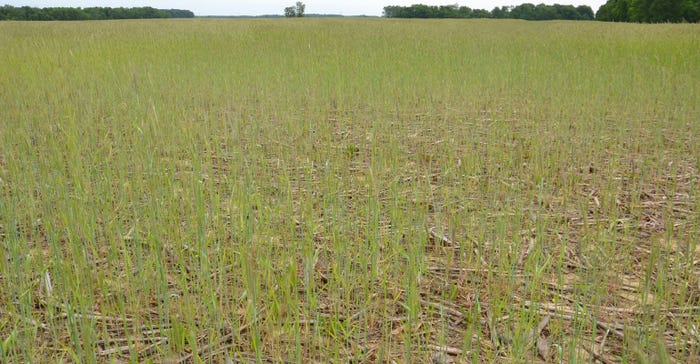
An essential part of season-long weed control is obtaining good burndown if you’re in a conservation-tillage system. Bill Johnson, Purdue University Extension weed control specialist, says that includes terminating cover crops successfully.
Here are three real examples that provide insight into the burndown of weeds and cover crops:
1. Tall weeds. The tall yellow weed in the photo above is senecio, also known as butterweed or cressleaf groundsel. It got a big jump in many fields in 2019 when saturated soils prevented timely burndown applications.
“The problem here is that glyphosate and 2,4-D don’t work all that well on senecio, especially at this stage,” Johnson says. Another option might be paraquat with 2,4-D and Sencor if you’re going to soybeans, he suggests.
Pay attention to plant-back intervals depending on which herbicides and soybean trait technologies you use. Remember to include residual herbicides with burndown applications.
2. Mixed weeds with marestail. The sprayer is already in the field in this example. What should be in the spray tank to match what’s in the field?

MARESTAIL ATTRACT ATTENTION: What goes in the tank should give you your best shot at knocking down tall marestail, Johnson says.

“The concern here are marestail pushing 2 feet tall,” Johnson says. Even though they’re in patches and not the only weeds in the field, they will likely be the toughest to bring down, he says. Ideally, this field would have been sprayed earlier when marestail was smaller.
At this point, assuming the field is going to soybeans, Johnson would advise dicamba or 2,4-D in the tank, along with Sharpen in both cases, unless it’s light, low-organic-matter ground. For those soils, pay attention to plant-back restrictions for Sharpen.
3. Thin cereal rye. At this stage of growth, the stand may not look thin from the road, but it’s on the thinner side for a cover crop.

COVER CROP SCENARIO: Check out Johnson’s comments if you anticipate needing to burn down cereal rye this spring.

Glyphosate should take down the cereal rye, Johnson says. Check the weather forecast. Glyphosate works better when it’s not cool or cloudy. That could affect the rate. You also may increase the rate if there are other weeds, especially winter annuals, to control.
Adding Sharpen to glyphosate would be an option to help on grasses and weeds. Check plant-back restrictions for soybeans with Sharpen on light soils. You might be able to substitute Sencor for Sharpen there, depending upon soil texture and organic matter. Check plant-back restrictions for Sencor, too. You may choose to avoid both these products if your planting window is too short.
About the Author(s)
You May Also Like




